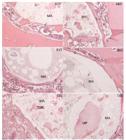Abstract
Purpose
To evaluate the polymer doped rods behavior with bioactive glass and hydroxyapatite for possible application as a fracture fixing method.
Methods
Twenty eight Rattus norvegicus Wistar underwent bone defect for access to the femoral medullary canal and distributed into three experimental groups: group A - doped castor bean polymer with bioactive glass; group B - castor bean polymer and; group C - castor bean polymer doped with bioactive glass and hydroxyapatite. After 15 and 60 evaluation days, the femurs were removed and sent for histology and scanning electron microscopy.
Results
Initially mild and moderate inflammatory infiltrate is observed that decreases as time goes by, and the presence of connective tissue capsule around the graft in all groups. Regarding the biomaterials resorption little was observed. The implanted rods did not favor the osteoconductive process in the femoral medullary canal which was observed only in the C15 group.
Conclusions
The association of castor bean polymer, bioactive glass and hydroxyapatite was biocompatible and osteointegrable. The osteoconductive only occurred in the presence of hydroxyapatite and bioactive glass (C15 Group) and little biodegradation was observed.
Key words:
Castor Bean; Polyurethanes; Durapatite; Biocompatible Materials; Rats

 Thumbnail
Thumbnail
